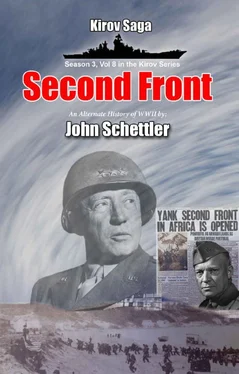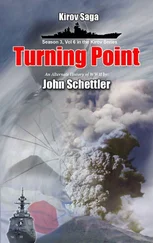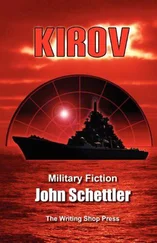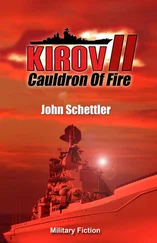DDG-180, Takami, Sea of Okhotsk, 20 May ~ 14:10
“Sir,” said the Navigator, “we should have range on them now. I make our position at 110 klicks from presumed enemy position. If we go active, I can nail that down to the meter for you.”
There it was, the moment of truth for Harada and Takami . He had eight archers with a single arrow each, and if he fired them now there wasn’t anything but the rail gun behind them at this range. He doubted he would get inside the range of his deck gun, and discarded that weapon in any case. The carrier based planes were already being engaged. It was now or never. He looked to Fukada, and Hideo Honjo a the CIC, and decided.
“This is it, gentlemen. Time to hit the dance floor. Lieutenant Otani, the ship will cease Silent Alpha and secure from EMCON. All radars will go active immediately. Lieutenant Shiota, signal both Sea Kings and order the same. Then advise Admiral Kurita that it might be best if he withdraws.”
Fukada was quick to repeat those orders, and soon the considerable power of the ship’s active radar was coming on line. The Sea Kings would go active as well, and feed their telemetry to Takami . In a matter of minutes their overlapping coverage would serve to pinpoint the location of Kirov . It was then that Harada played his ace, hoping it was good enough to take the hand.
“Mister Honjo, let’s throw some lightning—full salvo—all eight missiles.”
Claxons sounded, the missile warning hounding the nerves of the officers and crew, as it was designed to do. You never saw the enemy you were firing at, only the milky green phosphor of their presence as seen by electronic eyes. Yet you could see them in your mind’s eye, sitting before their technology, just as you were, watching, thinking, waiting.
The Vals and Kates off Kaga and Tosa were out there taking the heat from Kirov’s S-300s, but now eight fast arrows would lance out at the unseen enemy, and with them the fate of the campaign in the North Pacific would likely be written into this torn and shattered history that never should have been.
Sea of Okhotsk, 20 May ~ 14:18
Rodenkowas the first to feel the edge of the sensor shock wave when it lit up his board. He stared at the red light, blinked, his Mark 1 Eyeball seeing, yet not believing for that brief instant. Then he inclined his head, reached for a diagnostic switch, and nudged the system briefly to see that all was well. The judgment was in a few seconds later, and so he decided to report the mystery to command.
“Con… Very odd sir. I’m receiving a signal from the KA-226 indicating their Oko radar panel is being jammed.” That was the first indication that something was amiss. Takami ’s ECM systems were singing over the frequencies identified as active for the Oko Panel, and it had called home to report the offense.
“Jammed? Not possible,” said Karpov, giving Fedorov a sideward glance. “How could they possibly have anything that could bother our systems?”
That was a short lived assertion, no matter how true it might have been at one time. After Krakatoa, the Japanese suddenly had plenty to bother a ship like Kirov , and now, to Rodenko’s amazement, systems and electronic reflexes that had been idle for months suddenly perked up and began reporting an alarming train of information. Light after light began winking out new signals data, and the internal profiler was analyzing and reporting.
“What in God’s name? Sir, I have emissions profiles on I/J band frequencies… Analyzing…. This is impossible. It’s reading AN/SPG-62! And look here sir, we’re getting S Band emissions and the system is profiling that traffic as AN/SPY-1D, and I have three other signatures.”
“What are you saying?”
“This is crazy, sir, but That’s the emission profile for an Aegis class destroyer or cruiser. We’re being painted by long range target illumination radar!”
“An AEGIS destroyer? Nonsense. Here? Now?” Karpov looked at Fedorov. “Could we have shifted?” That was the first thing that came to his mind as his own internal systems sought to analyze and profile this impossible emissions traffic report. Clearly none of those emissions could be happening here in 1942, but the ship had a long history of pulsing—moving in time, and sometimes with little fanfare or sign that they had even shifted.
Fedorov looked around them, his eyes scanning the horizon, eyes narrowed, thinking. “Do we still have the helos?”
“Aye sir,” said Rodenko. “The 226 is still being jammed, but the KA-40 we just launched is clear, and I have a good telemetry link. That has to be the feed on these signals emissions, and I’m making the contact right here, just south of that surface action group we hit.”
“The goddamned command ship,” said Karpov. “But it’s clearly something much more. Fedorov? Sun and moon still where they should be? Anything amiss?”
“Not that I can see,” said Fedorov. “We’ve still got a line out to both our helos, and that surface action group is still hot and strong on the board. So my guess is that we haven’t shifted.”
“Rodenko,” said Karpov. “Could our system be malfunctioning, reporting false positives?”
“I’ve run diagnostics. With one errant signal, I might take a second look, but I’m now picking up five separate radar systems, and the KA-40 is pretty sure what it has by the tail out there. Look here, sir.” He read aloud now from his board data logger: “Bear 6 has been classified as DDG 180, Improved Atago Class. Admiral sir, this is an AEGIS equipped destroyer, JS- Takami, and the contact is hostile. Range, 80 nautical miles; bearing 180 true.”
That was all it was going to take for Karpov. Mystery or no mystery, he was all business now. The impossible could wait for further analysis in the after action report. Something was out there, jamming a modern day Oko class radar set on the KA-40 and writing its name all over the microwave frequency spectrum. If this was a system error, he could call himself stupid later. Now was the time to act. If it was a an error, all he would lose were the missiles he fired now. Every instinct in his body tensed up and told him he should barrage that target with no less than ten missiles, and make them hot. The one strident protest within him that refused to believe this could be happening gave him brief pause, and he lowered the missile count.
“Rodenko! Activate all offensive and defensive ECM systems at once—Bell Bash, Bell Nip, Bell Thump, Wine Glass—light them up! Samsonov. Put the S-300 system on full automatic, weapons free on any missile contact reported. Then put four Moskit-IIs on that contact immediately!”
“Aye sir. Four missiles ready and targeting Bear 6 now.”
“Fire!”
Kurita Group, Sea of Okhotsk, 20 May ~14:20
Takami had put all eight Type-12 missiles in the air, but traveling at just under the speed of sound, they would only get half way to their targets before Karpov’s anger found its way south on the hot tail fire of those four Moskit-IIs. Out on the weather deck of Haruna , Admiral Kurita had been watching the dizzy display of fireworks high up as Kirov’s S-300s had leapt upon the incoming air strike. Now the watchman called out another sighting, and he looked to see more rocket trails, this time coming from the south! How could this be possible? Were there two enemy ships, another behind him? Then he realized that these must be weapons fired from Takami , and that thought lifted his spirits.
He recalled his briefing with Admiral Yamamoto. “Scout well,” the Admiral had told him, “ and to aid that effort, I am attaching a very special ship to your task force, the cruiser Takami… a very secret ship, something entirely new. Do not think that the Siberians and Russians are the only ones who have developed this new rocket technology… it was designed as a fleet defense ship. Most of its rockets are meant to be used against enemy aircraft, or against the rocket weapons this Mizuchi flings at your ships.”
Читать дальше












